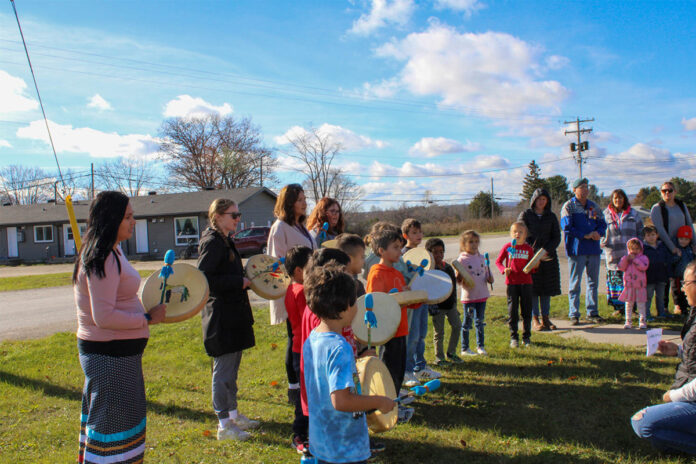SUDBURY—A group of determined fourth-year social work students transformed the Atrium of the Parker Building into a hub of education and reflection. Their goal during Treaties Recognition Week was to bring greater understanding to the Robinson Huron Treaty of 1850—a treaty that has shaped generations of Anishinaabe Peoples and remains relevant in contemporary Canadian life.
Guided by Dr. Elizabeth Carlson-Manathara, an associate professor of social work, students students Julia Cimino, Mili Patel, Chelsea Chamberland, Isabelle Mallette, and Savannah Beauchamp, led awareness-raising efforts as part of a final project for her course, *Strategies for Social Change*. “This project aimed to make the complexities and responsibilities of treaty relationships real for students,” Dr. Carlson-Manathara said. “It’s an opportunity to not just talk about social justice but live it.”
One of the students, Julia Cimino, reflected on her motivations: “As a non-Indigenous person, I have a responsibility to understand the history and impacts of colonization and to honour the treaties that continue to shape this land.” Alongside her, students like Mili Patel set up booths brimming with educational pamphlets, historical displays, and interactive QR codes that invited visitors to learn more about treaty obligations. “Our goal was to engage our community and help people understand the significance of the Robinson Huron Treaty,” Patel explained. “We are all treaty people, and that means we have roles to play.”
Throughout the week, Laurentian University became a gathering place for powerful teachings and reflections. The Robinson Huron Waawiindamaagewin and the university’s Office of Academic and Indigenous Programs organized events that brought together community leaders, legal experts, and scholars. Notable speakers included Dr. Alan Corbiere, who spoke about the historic roots of the 1850 treaty and the responsibilities of Anishinaabe leadership, and Dr. Brian McInnes, who delved into the cultural significance of wampum belts as a record of sacred agreements. Anishinaabe lawyer Daniel McCoy provided a contemporary legal perspective, emphasizing the recent Supreme Court ruling that mandates increased annuity payments tied to resource use—a ruling that recognized Canada and Ontario’s need to honour treaty obligations.
The historical context of the treaty’s payment struggles resonated with attendees. For decades, the 21 First Nations signatories of the Robinson Huron Treaty had advocated for fair compensation based on resource sharing, a fight that culminated in legal victories. The settlement confirmed their rights to increased annuities, yet challenges remained. “This ruling isn’t just about money; it’s about respect and fulfilling promises,” McCoy said. “Our work now involves meaningful negotiations to ensure these promises are met and to move forward in true partnership.”
The impact of the treaty’s history was brought to life by stories shared by Elders and historians. Dr. Corbiere highlighted the 1874 journey of chiefs to Montreal to negotiate treaty augmentations, emphasizing the courage and persistence of those who fought for their people’s rights. He spoke passionately about the need to preserve and teach Anishinaabe law, which extends beyond the treaty itself. “Our laws and traditions must be a guiding force—not only for us but as an example for other treaty areas grappling with broken promises.”
Language preservation, traditional kowledge, and the role of Anishinaabe governance were recurring themes. Dr. Corbiere spoke of the sacred responsibilities of chiefs, rooted in cultural and spiritual practices like fasting and vision quests. “Leadership is about providing for and protecting our people, honouring traditions, and keeping our promises alive,” he said, as he recounted personal stories of fasting and visions that guided leaders’ paths.
The week’s events also emphasized the importance of language revitalization, with speakers underscoring the centrality of Anishinaabemowin in cultural preservation. Conducting business and sharing knowledge in the original language were described as acts of sovereignty and cultural strength.
Laurentian University’s commitment to treaty education extended to preserving the legal and historical records of the Robinson Huron Treaty litigation. Dr. Natasha Gerolami described efforts to make these records accessible to First Nations communities while respecting traditional protocols. “Our role is to ensure that these documents and stories remain a living part of our collective understanding,” Gerolami said.
Dr. Elizabeth Carlson closed the week’s events with a call to action for non-Indigenous allies. “Understanding treaties is about understanding relationships—past, present, and future. It’s about living our responsibilities every day.”
The gathering ended with geteh shkode (fire teachings) outside the Indigenous Sharing and Learning Centre’s Round Room, where community members reflected on the path forward. The renewed commitment to treaty recognition, Anishinaabe law, and mutual respect will continue to shape conversations in Robinson Huron Treaty territory and beyond.






